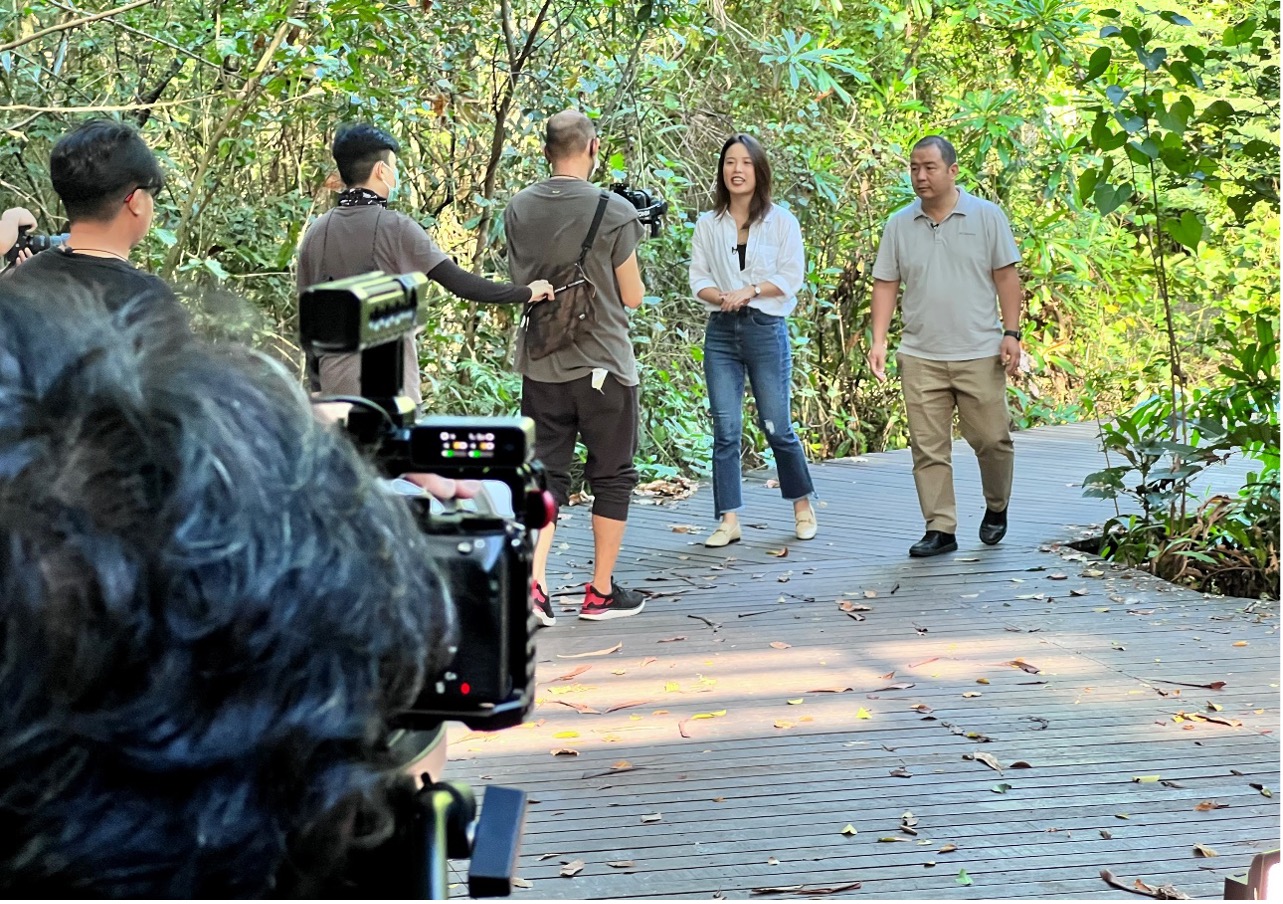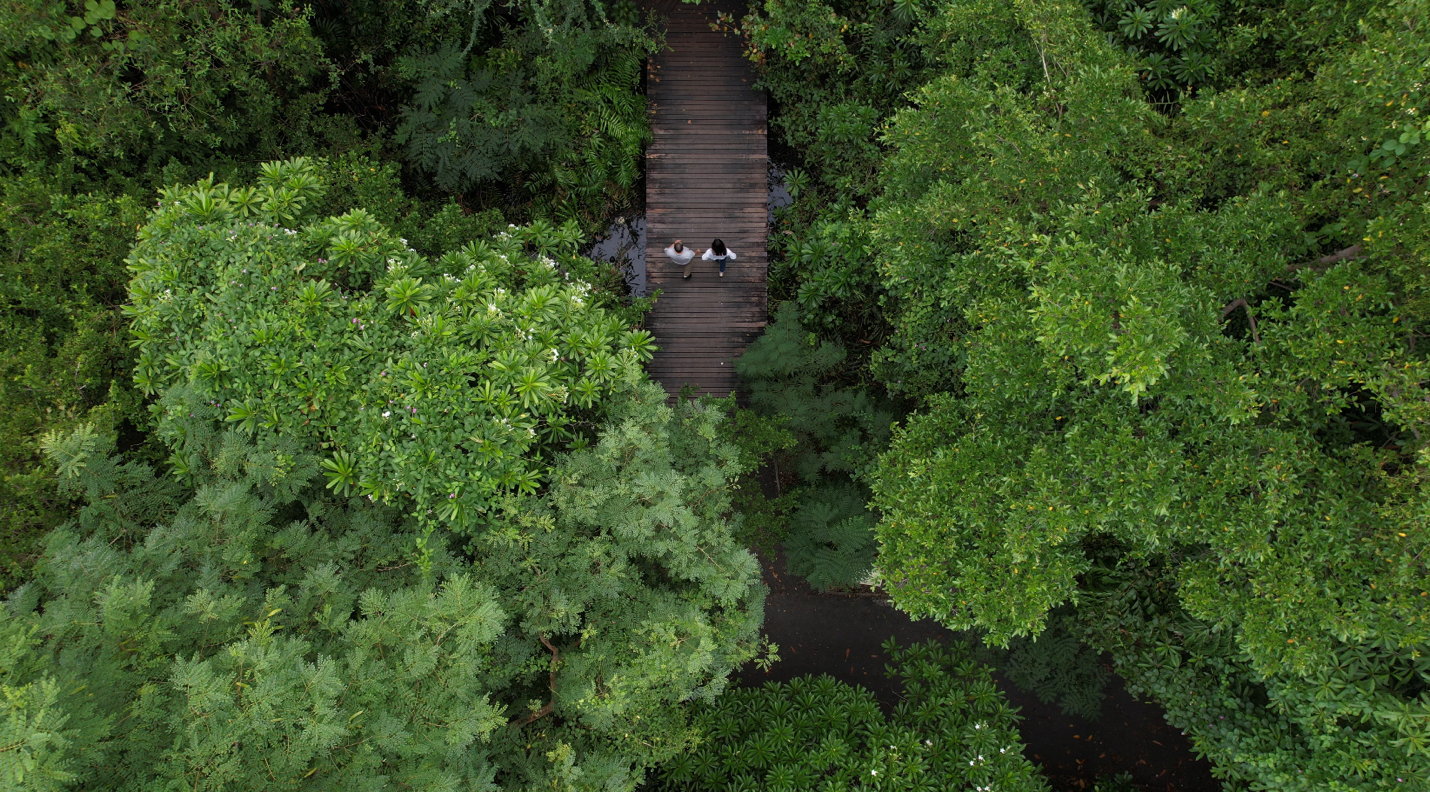Written by Sean Lees with Doley Tshering
COP15 and Beyond: Biodiversity, Human Rights and the role of Business
December 1, 2022

Bang Krachao Island is a green oasis in the heart of Bangkok.
Like many cities in Southeast Asia, Bangkok is a city of sharp and colorful contrasts that can both confuse and elevate the senses. On a warm morning walking down Sukhumvit avenue, a busy street hosting spicy sausage hawkers and high-end shopping malls, I am overwhelmed by a cacophony of noises and smells. A monorail train whistles overhead. A tuk-tuk drives by blaring like an angry trombone. But just a few kilometers away, I board a thin canoe with an outboard motor, and suddenly find myself in the shadows of giant Tualang trees and Nipa, Raja and Bismarckia palms.
Here on Bang Krachao Island, across the Chao Phraya River, one finds an extraordinary place of quiet repose. Referred to by locals as Bangkok’s “green lung,” Bang Krachao is a small bit of wilderness offsetting the drum of machinery in the city and hinting at Bangkok’s past as a biodiversity hotspot. In Sri Nakhon Khuean Khan Park, we gather to shoot an interview with Doley Tshering, Senior Advisor for Ecosystems and Biodiversity at UNDP. Doley is one of the guests for our latest webcast programme called Asia in Focus, covering corporate sustainability issues in the region. In partnership with the European Union, Asia in Focus hosts regional experts who articulate the connection between business, the environment, and human rights.
The cameramen are setting up their tripods now, beneath a bird-watching tower. As an amateur filmmaker in an earlier stage of my life, I admire their extensive collection of video cameras, lenses, headphones, and audio equipment. They train their cameras on the waters and trees around them for “cutaway” and “B-roll” shots.
Bang Krachao is an appropriate place to shoot this segment of our webcast with its primordial ferns, swampy alcoves and leathered monitor lizards serving as a backdrop. But is it a setting worth celebrating or a sad reminder of what has been sacrificed in the name of unrestrained economic growth?
Southeast Asia is losing its biodiversity assets at break-neck speed to satisfy unrelenting consumer demand for vegetable oils, beauty products, chocolate candies, and electronic consumer items, including the camera equipment I so covet. As Doley explains with the cameras rolling,“starting from 1970, wildlife has declined by 55 percent in Asia. In just one lifetime, Asia has lost 40 percent of its coral reefs and 60 percent of its mangroves.”
Southeast Asia also has some of the highest deforestation rates in the world, with an estimated 15 percent of regional forest cover lost over the last 2 decades. Deforestation has mostly been driven by the operations of underregulated agribusiness, extractives, and charcoal production companies.
The human rights implications of deforestation have been significant. Biodiversity loss puts at risk the right to livelihoods, the right to clean air and water, the right to culture and the right to a clean, healthy, and sustainable environment. Sometimes land is cleared after dodgy land acquisition deals are finalized. These agreements result in “land grabs” and the forced displacement of Indigenous Peoples and communities. The relocation of villages has its own impacts, as traditional knowledge and cultural connections to the land is lost, and the hunting of wildlife and other activities increases.
As Doley does a second take for the camera, I start contemplating the environmental impact of the many pieces of video gear we brought here to make this shoot. How much raw material—tin, tantalum, tungsten, nickel, cobalt, lithium, and manganese—was needed to make these cameras, their batteries, and the servers that host our webcasts? How much carbon did we burn transporting all these people and equipment here?

An interview segment of Asia in Focus with co-host Sheila Yuan and Biodiversity expert Doley Tshering.
I am in the editing studio now with our media partners and looking at our footage on a monitor. I am reminded of the conversation we had with Dr. Surya Deva on our Asia in Focus webcast on Climate Change. Then, Dr. Surya Deva pitched a degrowth strategy to solving environmental pressures to my incredulous ears. Business, he suggested, should not encourage us to consume so much. At the time, the notion sounded anti-capitalist, unpractical and maybe even self-defeating. As the host of the webcast, I gently moved the conversation to another topic.
I have since learned that a degrowth agenda does not necessarily require us to slow the pace of development. Instead, degrowth can also imply supply chain optimization, improved efficiency in extracting and using raw materials, wasting less in the production of products while pursuing profits and job creation.
As consumers concerned with biodiversity loss and its human rights impacts, we have a role to play in the pursuit of degrowth. For example, we can decide during this busy holiday season to purchase fewer goods and only those goods that have a repair and return policy, or that have a reputation or guarantee of long-term durability.
Importantly, we can also support emerging legislation that improves corporate sustainability practice, such as environmental and human rights due diligence, and new regulations that mandate durability requirements designed to reduce waste. We can also support emergent regulations that limit imports implicated in deforestation.

Mangrove trees and other tropical plants are scattered all around Bang Krachao.
On the immediate horizon (7-19 December 2022) is the 15th Conference of Parties (COP15) for the Convention on Biological Diversity where some of these initiatives will take shape during negotiations hosted in Montreal, Canada. Widely considered the most important meeting on biodiversity in a decade, governments will negotiate a Global Biodiversity Framework at COP15 which will serve as the global strategic plan for biodiversity through 2030. Among targets under discussion include the transformation of economic sectors, to address the root drivers of biodiversity loss (Target 14) and targets to develop regulations supporting corporate disclosures on biodiversity impacts (Target15). There will also be discussions on efforts to reduce food waste and eliminate subsidies that lead to biodiversity loss. Notably, COP15 will attempt to agree with the idea of conserving 30 percent of the Earth’s land and seas by 2030 – known as the 30×30 target. But the devil is in the details: 30 percent of what land and which seas?
Certainly, UNDP will be doing its part to raise awareness and push our collective ambitions at COP15. Our webcast is but a tiny contribution to a much larger movement. Still, as Doley explains on the monitor in the editing room, “biodiversity loss may have catastrophic consequences for humanity. For this reason, all hands need to be on deck. Everyone needs to do their part.”

 Locations
Locations